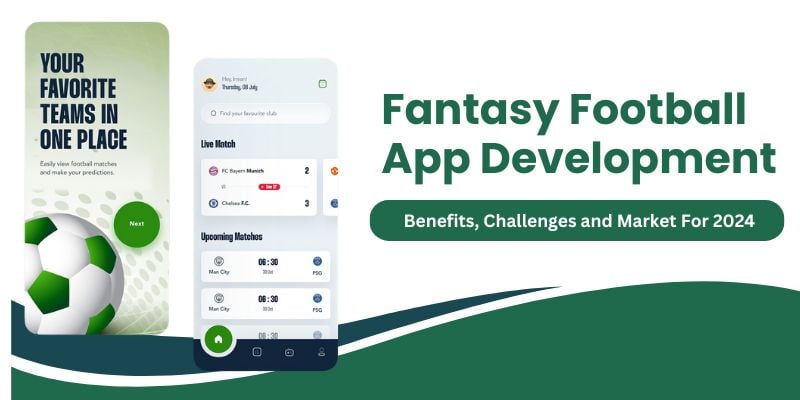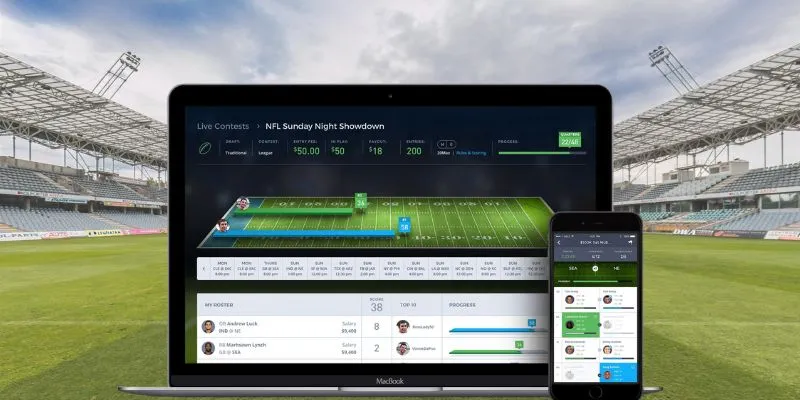The fantasy football app has been gaining popularity and has captivated millions of sports fans around the world. This blog explores the complex world of fantasy football development and reveals the essential aspects that make these apps popular with fans.
Fantasy football apps have evolved into an international phenomenon that draws millions of fans seeking an engaging way to get in touch with their favourite players and teams. For those new to the field, navigating the complex terrain can be challenging. This guide is designed to simplify the realm of fantasy sports, offering a complete overview of its most important aspects:
The Core Concept
Fantasy sports lets players create virtual teams of real athletes from different sports leagues. Players' performance can be translated into points for the team, and the objective is to beat the other players and win in competitions or leagues.
Diverse Offerings
Fantasy Football app development company aren't limited to the conventional possibilities of basketball, football, and baseball. Fans today can play fantasy sports for many different sports, such as golf, hockey, cricket, and esports. There are even reality television shows based on fantasy.
Different Playing Styles
They cater to different tastes through a variety of game styles. Season-long leagues that require dedication and long-term planning provide a solid relationship to the sport over the entire season. However, Daily Fantasy Sports (DFS) is a fast-paced, lively experience. New teams are designed for each game and require strong analytical skills and the identification of undervalued players.
Salary cap leagues provide an additional layer of strategy by requiring players to create teams with a budget and assess their negotiation and budgeting abilities. Head-to-head leagues give players a personalized and competitive experience, where players compete against each other and must comprehend both player performances and their opponents' rosters.
In addition, scoring systems can be based on points, where you win with a total of points, or categories-based, in which the winning of the highest lab statistical category results in winning. With the variety of options available, fantasy football development permits users to choose a playing style that best suits their interests and preferences.
The world of fantasy sports offers diverse playing styles to satisfy different tastes and levels of skill. Here are some of the most popular choices:
Season-Long Leagues
Users draft players and then manage their teams during the entire sports season.
Daily Fantasy Sports (DFS)
Participants form teams to compete in each game, providing the opportunity for a lively and exciting experience.
Salary Cap Leagues
Users have the chance to create a virtual budget for their team, which adds an element of strategic development.
The Economic Engine
Fantasy football apps bring in significant profits via various channels, such as:
-
-
Entry fees: Participation in leagues and contests usually involves an entry fee, contributing to the overall revenue stream.
-
Advertising: Platforms use advertising to earn money by displaying products and services to a very engaged audience.
-
A few platforms provide premium features or subscription tiers with additional functions at a cost.
Legal Landscape and Other Regulatory Issues
The legal environment concerning fantasy sports differs across various regions. Knowing your area's specific rules is essential before creating a fantasy football app or entering contests involving real money.
Market Overview- Fantasy Football App Potential
Fantasy football goes beyond entertainment and is now an essential social media platform. In the U.S. The 20 plus million gamers who play fantasy football are part of a growing $7 billion business. These fans aren't fans on the go; they're passionate people who want to invest their time and money.
A Large User Base
Fantasy Sports and Gaming Association's statistics show that there is a large user base of spending power. The reason is that the players pay an average of $556 per year for fantasy sports.
Engagement and Retention
The average fantasy player spends more than eight hours a week managing the team and conducting player research, evidence of the game's fascinating nature.
Potential for Revenue
The Fantasy football apps can take advantage of this profitable market with numerous ways to monetize, such as in-app purchases and premium subscriptions.
Benefits of Fantasy Football App Development
The football fan base is growing daily. Developing a fantasy football app will reap many benefits. Here are a few reasons to invest in developing one. Let's look.
Revenue Generation
One significant benefit of creating a fantasy football app is the possibility of revenue generation. Fantasy football apps give the user a variety of revenue streams, such as advertising, in-app purchases, premium subscriptions, premium memberships, and sponsorships. You can use these revenue streams to boost the value of your app and create an ongoing revenue stream.
Also Read: A Comprehensive Guide For Fantasy Football App Development
Increased Brand Awareness
The fantasy football development will boost brand awareness. When the app becomes popular, it will draw more users, thereby increasing the visibility of the app's creator and popularity in the field. In addition, the app could be developed to incorporate branding elements, like logos and colors, that can help reinforce your brand's image.
User Engagement
Fantasy football apps will allow you to interact with your users and create communities around your brand. The app could offer options like in-app messages, social sharing, and community forums that provide an environment for users to connect. Encouraging engagement among users can build an engaged user base and develop a sense of brand loyalty.
Data Collection
Fantasy football apps offer essential user information, such as user preferences, behaviours, and engagement patterns. These data can be utilized to guide the future development of product marketing strategies, product development, and business decision-making. Analyzing user data allows you to learn about user behaviour and preferences, enabling you to create your application and marketing strategies to better satisfy the user's needs.
Competitive Advantage
A well-designed, popular fantasy football app could provide an advantage. When the app becomes more popular and can attract new users, rivals will take more work to enter and increase market share. Additionally, you can use user data to find areas of opportunity and create new services or features to satisfy users' needs better and distinguish yourself from competitors.
Also Read: List of Best Fantasy Football Apps in USA
Ultimately, fantasy football development can be a wise option if you're trying to increase revenue, boost brand recognition, and connect with users engagingly. By leveraging the advantages of app development, you will be able to develop a winning app that can drive your company's growth and profits.
Challenges in Developing a Fantasy Football App
A few challenges will be faced during the development of this fantasy football app. Check them out below.
Data Integration
One of the most challenging aspects of developing a fantasy football app is integrating the large quantities of data needed to manage and create virtual teams. The information includes player stats, injuries, and game schedules. It must be continuously updated in real time to provide users with up-to-date data. Building the infrastructure necessary to allow real-time data integration is complicated and long-lasting.
Also Read: Ultimate Guide To Fantasy Sports App Development
User Engagement
Although fantasy football apps can be extremely engaging, players could lose enthusiasm if they don't feel the app is compelling or encounter technical issues. To avoid this, make sure that the app is simple to navigate, visually appealing, and gives an enjoyable user experience.
Monetization
There are many possibilities for monetizing fantasy football apps, including in-app ads and subscriptions. You need to find a way to balance generating revenues while maintaining engagement with users. Intense advertising or subscription costs that are too high may make users uninterested and contribute to low retention rates.
Security
Fantasy football apps gather large amounts of sensitive information, including personal and payment information, and can be an easy target for hackers and other cyber attacks. To safeguard user data, you should implement strong security measures, like two-factor authentication and encryption, and frequently change your security protocols to keep up with new threats.
Competition
Fantasy football apps are highly competitive, with various established players competing for interest. To make your mark in this market, you have to offer your users a distinct value proposition, like high-end analytics and social functions, and constantly update and enhance your app to satisfy users' needs and preferences.
Target Audience for Fantasy Football Website
Determining the audience you want to target for a fantasy football app is essential for adjusting content, features, and the user experience. This guide can help you identify and understand your ideal audience.
Demographics
-
-
Age: Decide the age range of the target group of players. Fantasy football is popular with all ages. However, you may target a particular area between 18 and 35 or 25 and 45.
-
-
-
Gender: Consider your customers' demographics, whether they are predominantly female or male, or if you would like to serve a diversifying audience.
-
-
-
Location: Your fans' geographical area is important because your audience's location influences the popularity of fantasy football.
-
Experience Level
Decide the audience you want to target, whether casual or novice players, experienced football fans, or a mixture of all different levels. Create content tailored to their needs, including tutorials for beginners and advanced strategies for experienced players.
Time Commitment
Choose whether your fan base prefers a quick and casual approach or is committed and wants to spend more time running their fantasy team.
Device Preferences
Learn whether your target audience prefers to access the fantasy football app through desktop or mobile devices. Make sure your website is optimized to work on that platform.
Social Engagement
Determine whether your target audience is interested in playing the game alone or prefers to play in leagues with family, friends, or colleagues. Consider incorporating social features to improve the experience for all players.
Content Preferences
Determine your target audience's preference for being attracted to specific statistics, analytics, and deep player insight or would prefer to take a narrative story-based approach to games.
-
-
Hobbies and Interests: Consider your target audience's many interests beyond fantasy football. This information can aid you in integrating relevant content, promotions, or partnerships that align with your interests.
-
-
-
User Feedback: Gather feedback from users already using the service better to understand their preferences, needs, and issues. Conduct surveys or utilize analytics tools to gain important information.
-
How to Create a Fantasy Football Website
Fantasy football development requires an arduous planning process, a dedicated team, and a strategic approach. From research and planning to the exciting launch, every step is crucial to the overall success of your online venture. Let's explore the most critical aspects of creating an online platform for fantasy football.
Research and Plan for a Fantasy Platform
Before you begin development:
-
-
A thorough study of current fantasy sports platforms.
-
Recognize gaps, know users' preferences, and determine the distinctive features your website will offer.
-
Make a thorough plan outlining your goals, audience, and the particular features you'd like to provide.
-
Have a Strong Team of Developers
A skilled and committed team of developers is crucial in developing your dream football site. Be sure your team members have experience in web development, including database management and the integration of live data from sports.
Choosing the Best Website Developing Partner
It is crucial to choose the right business to develop your sports application. Choose a fantasy app development company with the best track record, a profound understanding of your concept, and the technical expertise to bring it to reality.
Search for the Right Sports Application Development Company
Evaluate and research prospective development partners. Please take note of their experience, client portfolio testimonials, and ability to adjust to changing technologies. A trustworthy partner can be instrumental in helping you transform your vision into a solid fantasy football site.
Choose a Domain Name and Features
Pick a memorable and meaningful domain name that conveys the nature of your fantasy football app. Determine the essential features the website will offer, such as player databases, team management tools, live score updates, and a customizable league setting.
Build a Scalable Architecture
Check that your website's design is flexible enough to accommodate the increasing number of users and enhancements to features. Opt for an agile and durable structure that can adjust to the dynamically changing fantasy sports world.
Choose Your Brand Identity
Create a unique brand image that relates with your targeted customers. This involves creating a memorable logo, selecting the color scheme, and creating a unified visual language that distinguishes your fantasy football app from the rest.
Implement Crucial Features
Integrate vital features like players' databases, real-time score updates, draft capabilities trading options, and draft functionality. Adjust these features to improve the user experience, ensuring an enjoyable and seamless experience for fans of fantasy football.
Launch Your Website
After a thorough stage of fantasy football development and testing After a stringent development and testing phase, you can create your fantasy football site. Create a marketing strategy to attract attention, use social media, and think about collaborations with sports influencers or other organizations to increase visibility. Inviting users to sign up, collecting feedback, and constantly improving your site based on user feedback.
Cost to Develop a Fantasy Football App
Naturally, the price of creating fantasy football apps can differ significantly based on the features you want to include and the functions you wish to add. However, some experts believe that creating a simple app with standard features can cost anywhere between $50,000 and $100,000. This includes the design and fantasy football development, as well as testing and launching it.
Costs will increase significantly for more sophisticated features, such as AI software or streaming live. However, considering fantasy football games' potential earnings and popularity, it is a good investment for any individual or business seeking to enter the market.
Basic App Development
The price for creating a fantasy football app that is basic and includes standard features such as live scores, player news updates, and customizable ranking is believed to be between $50,000 and $100,000.
Advanced Features Integration
If you intend to integrate more advanced features such as AI algorithms to determine the player and live broadcasting of sports, the enhancements can significantly increase the cost. It isn't easy to estimate an exact figure without precise information, but the 25 to 50 percent increase is not unusual.
User Interface and Design
The more intricate and interactive your user interface is, the more expensive the development cost. Your app must be attractive and easy to use to draw and keep users. It could add another $10k to $20k to your total budget.
Test and Launch
Rigorous testing is a different aspect of ensuring the application's security, functionality, and effectiveness. Depending on the size and length of the testing phase, this can add between $10,000 and $15,000.
Maintenance and Updates
Following its launch, the application needs regular updating and maintenance to ensure it runs smoothly and stays in the game. This factor is considered in the ongoing costs, which vary from $5,000 to $10,000 per year.
Marketing and Promotion
To ensure that your fantasy football app reaches the desired target audience, a percentage of your budget must be allotted to promotion and marketing. The amount of your campaign to promote it can be anything from a few thousand dollars to several thousand dollars.
Conclusion
The fantasy football app market is full of potential and is characterized by a genuine and active audience. By using the power of strategic development, prioritizing user involvement, and providing the most comprehensive features, developers can develop an app distinctive from the other fantasy sports apps in the market.
Are you ready to establish yourself on the market for fantasy football apps? It's time to work with a team of developers with experience and an in-depth understanding of the market's requirements. The development of fantasy football apps exceeds users' expectations, and you will achieve a top position in the fantasy sports global community.












Share this blog